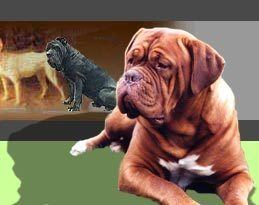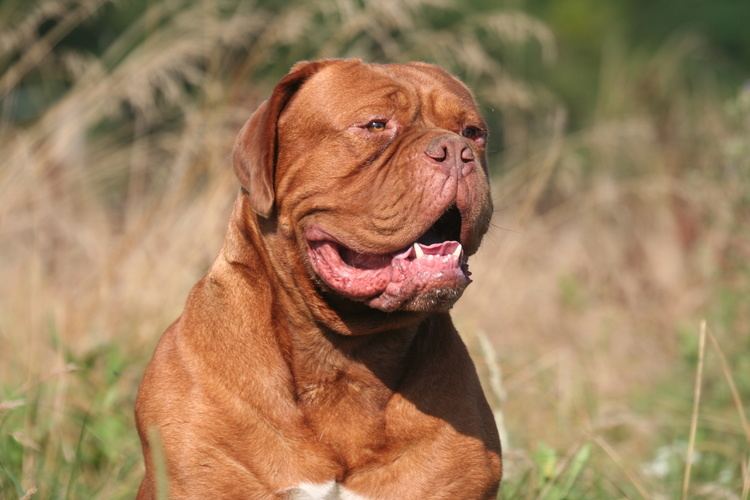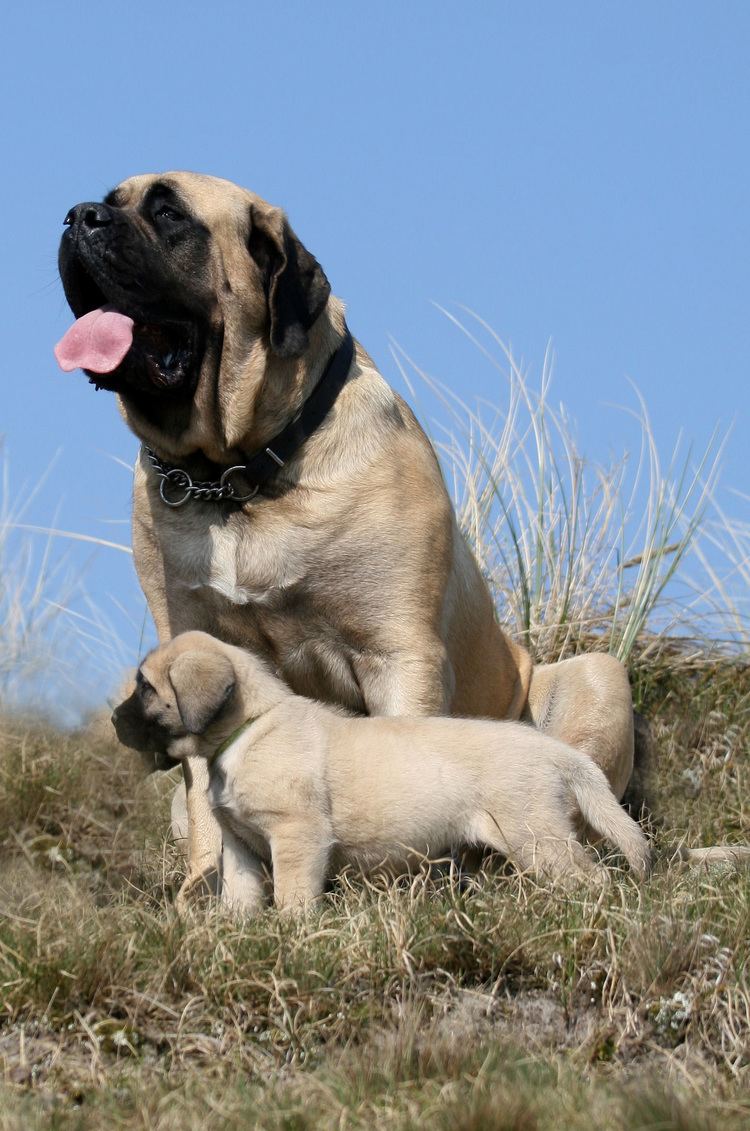 | ||
Length Appenzeller Sennenhund: 47 – 58 cm Height English Mastiff: 76 cm, Cane Corso: 62 – 72 cm Mass Bulldog: 23 kg, English Mastiff: 68 – 110 kg Lifespan Bulldog: 8 – 10 years, English Mastiff: 7 – 11 years Representative species Bulldog, English Mastiff, Cane Corso, Great Dane, French Bulldog | ||
Molosser breeds
Molosser is a category of solidly built, large dog breeds that all descend from the same common ancestor. The name derives from Molossia, an area of ancient Epirus, where the large shepherd dog was known as a Molossus.
Contents
- Molosser breeds
- Gpa nationals titan owned by molosser republic
- Origins
- Function
- Development
- Mastiff confusion
- Recognized breeds
- Unrecognised breeds
- Smaller Molosser breeds
- References

Molossers typically have heavy bones, pendant ears, a relatively short and well-muscled neck, and a short, broad muzzle.
Gpa nationals titan owned by molosser republic
Origins

Nineteenth-century army veterinarian and entomologist Jean Pierre Mégnin theorized the four basic canine races, based on his observation of their different skull structures, are: Lupoides (Spitz), Braccoides (scenthounds), Graioides (sighthounds), and Molossoides (mountain dogs, Mastiff breeds, and even Pugs). Although study of the canine genome is causing the revision of phenotype-based taxonomies such as Mégnin's, the four categories are still used in some traditional contexts.
Function

Molossers are used for a variety jobs that require strength and size. Some molosser types are used for search and rescue dogs, such as the Newfoundland and the Saint Bernard. Some are used as guard dogs to protect property from intruders. Livestock guardian dogs live alongside livestock and offer protection against large predators and poachers. The Greater Swiss Mountain Dog has been used as a cart dog.
Development

The oldest known record of a molosser-type dog is found in its name, which is the namesake of the people who first used these dogs: Molosser is an eponym of King Molossus, the grandchild of the mighty Achilles famed in the Trojan War, who ruled the ancient tribe of Molossians in Epirus. Since the ancient region of Epirus has historically been claimed by such modern countries as Greece and Albania, some dispute exists over the molosser's exact origin. The people of Epirus were a seafaring people, and these dogs sailed with their masters to Asia, where selective breeding gave them multiple phenotypes that were better suited to their new climates and roles.

As these ancient Molosser dogs were exported to West Asia, Central Asia, South Asia, and North Africa, they soon adapted to their surroundings and interbred with local dogs resulting in offspring with shorter, differently colored coats but retained more anatomical morphology traits like height and massive heads with short muzzles.
The dogs were considered valuable in Babylon, and are mentioned in cuneiform in the 4th century BC. A large Mastiff-like dog is shown on the ancient terra cotta by Birs Nimrud. The dog is 90 centimetres (35 in) tall at the withers, has a stocky head and powerful hind quarters. The dogs were used for hunting in ancient Assyria. Archeological digs of the Ashurbanipal palace (7th century BC) revealed pictures of dogs felling wild horses and donkeys. Assyrian Mastiffs were also used for military purposes and for protection.
The ancient Mastiffs would later be imported from Assyria and Babylon to Egypt and Asia Minor. Xerxes I of Persia led predatory wars to enlarge the borders of his empire, taking with him large war dogs in his army. Mastiffs were used to fight in the Roman amphitheater against lions and may have been used in lion hunting. They are the root of many shepherd and mountain dog breeds.
The Alans kept Mastiff-like dogs taken from Eastern Europe which acted as retrievers, guard dogs, and fighting dogs. The name associated with these dogs is Alaunt, or in Spanish, Alano. The Mastiffs were used in unison with sighthounds to hunt wisent, aurochs, and bear. Groups of Alanian tribes came to Europe during the Migration Period, fighting on the territory of modern Portugal, Spain, France, Italy, and North Africa, taking with them their dogs. The Alanian Mastiff then spread to the British Isles. The Mastiffs of the Alps, the Alpine Mastiff, was a progenitor of the St. Bernard and contributed to the modern English Mastiff.
The Newfoundland dog is the only Canadian Molosser-type dog breed. Portuguese fishermen have fished off the shores of Newfoundland for centuries, and the Newfoundland breed was the result of Portuguese Mastiffs breeding with St. John's water dog.
The Bulldog breeds split from the Molossers in Europe and spread to the New World with colonization. Though smaller, Bulldogs are still considered to be Molosser breeds.
In contemporary culture they are also known as Mastín (Spanish), Dogue or Dogo (Romance languages), and Dogge (Germanic).
Mastiff confusion
Breeds such as the Fila Brasileiro, Pyrenean Mastiff (Mastín del Pirineo), Spanish Mastiff, Tibetan Mastiff, Cane Corso, and many others that fall into the larger category of "molossers" are of Mastiff-type, but are not true Mastiffs. The term "Mastiff", when used alone, refers specifically to the "English Mastiff" breed. Other true Mastiff breeds include the Dogue de Bordeaux, Neapolitan Mastiff, and Bullmastiff. Each is a separate and distinct breed. The Boxer breed is also included, as it is a creation from other molossers including the Old English Bulldog.
Recognized breeds
This is a list of all breeds that fit into the Molosser category of dogs.
1. Argentina
2. Brazil
3. Canada
4. China
5. Denmark
6. France
7. Germany
8. Germany/Switzerland
9. Great Britain
10. Hungary
11. Italy
12. Japan
13. Morocco
11. Pakistan
14. Portugal
15. Russia
16. Serbia
17. Slovenia
18. Spain
19. Switzerland
20. Tibet
21. Turkey
22. United States of America
23. Uruguay
Unrecognised breeds
1. Afghanistan
2. Armenia
3. Azerbaijan
4. Brazil
5. Canada
6. Greece
7. Guatemala
8. Italy
9. India
10. Iran
11. Korea
12. Kurdistan and Iraq
13. Mongolia
14. Nepal
15. Poland
16. Russia
17. South Africa
18. Tibet
19. United Kingdom
20. United States of America
Smaller Molosser breeds
1. China
2. England
3. United States of America
